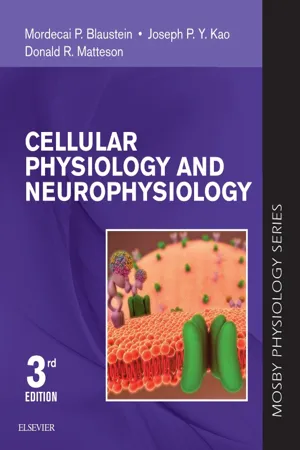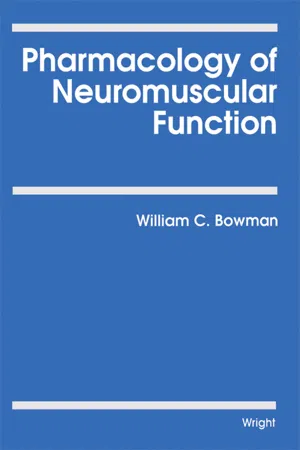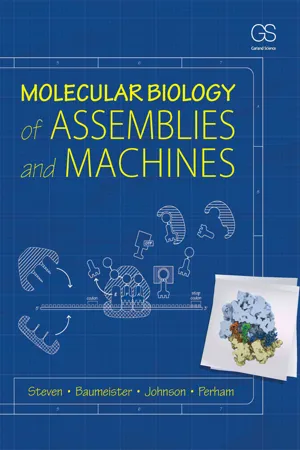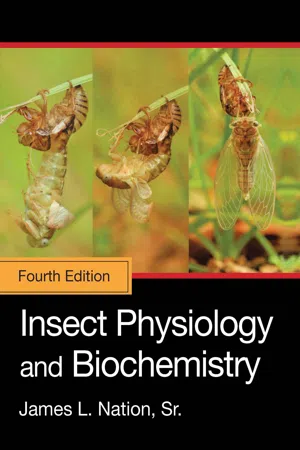Biological Sciences
Sliding Filament Theory
The Sliding Filament Theory explains how muscles contract at a molecular level. It proposes that during muscle contraction, the thin actin filaments slide past the thick myosin filaments, causing the sarcomere unit to shorten. This process is driven by the interaction of myosin heads with actin filaments, powered by ATP hydrolysis.
Written by Perlego with AI-assistance
Related key terms
Related key terms
1 of 4
Related key terms
1 of 3
8 Key excerpts on "Sliding Filament Theory"
- eBook - ePub
Cellular Physiology and Neurophysiology E-Book
Cellular Physiology and Neurophysiology E-Book
- Mordecai P. Blaustein, Joseph P. Y. Kao, Donald R. Matteson(Authors)
- 2019(Publication Date)
- Elsevier(Publisher)
Muscle: Proceedings of a symposium held at the Faculty of Medicine, University of Alberta. Oxford, UK: Pergamon.)Fig. 14.8 The Sliding Filament Mechanism. (A) Schematic drawing of a muscle in a relaxed state. There is little overlap between thin and thick filaments. The projections from the thick filaments are the arm and globular head regions of the myosin molecules that form cross-bridges to the thin filaments. (B) Schematic drawing of the same muscle during a contraction. The thin filament has slid along the thick filament so that they overlap each other to a greater extent. Note that in the contracted state, both the H zone and the I band are narrower but the A band is unchanged.In the region of filament overlap, short connections, or cross-bridges, project from the thick filaments toward the thin filaments (Fig. 14.8 ). The molecular basis for filament sliding involves cross-bridge movement. The cross-bridges attach to and pull on the thin filaments to cause sliding of the thick and thin filaments past each other. This increases overlap between the filaments and shortens the sarcomere.The cross-bridge cycle powers muscle contraction
Cross-bridge movement produces filament sliding in the following way (Fig. 14.9 ): the myosin head attaches to an actin filament to form a cross-bridge. The head then rotates toward the myosin tail, thus pulling on the thin filament and causing it to move relative to the thick filament. The head detaches and rotates back to its original orientation, and the cycle can repeat. This mechanism is analogous to rowing a boat. The oar is dipped into and pulled through the water (myosin binding and rotation; the “power stroke”), the oar is pulled out of the water and pushed back to its original position (myosin detachment and “recocking” of the head), and a new stroke can begin. These mechanical steps are coupled to the hydrolysis of ATP, which is catalyzed by the myosin head during its interaction with actin (i.e., myosin is an ATPase). The cyclical sequence of steps (Fig. 14.9 ), the cross-bridge cycle - eBook - ePub
- William C. Bowman(Author)
- 2013(Publication Date)
- Butterworth-Heinemann(Publisher)
Chapter 7Muscle contraction
Publisher Summary
This chapter discusses the theory of muscle contraction. According the theory of contraction— the Sliding Filament Theory—contraction is the result of the myofilaments sliding over one another, that is, it is a consequence of increased interdigitation of the myofilaments. In a muscle at its relaxed resting length, about two-thirds of the length of each thick filament and about half of that of each thin filament are overlapped. The process of contraction is a consequence of the formation of cross-bridges between the globular heads of the thick myosin filaments and the G actin units of the thin filaments. The cross-bridges are rapidly formed and broken, each detaching itself from one site on the thin filament and reattaching itself to another site further along and so on, with the result that the thin filament slides along the thick filament, like a line of men pulling in a rope hand over hand. Relaxation to the resting muscle length occurs because cross-bridges cease to be formed, allowing the filaments to readjust to the resting degree of interdigitation. Drugs may increase or decrease the contractions of striated muscle by affecting one or more of the processes in the excitation–contraction coupling sequence. The ultimate cause of the altered contractility is usually a change in the rate of Ca release from, in the amount of Ca2+ released from or in the rate of Ca2+ reuptake by, the sarcoplasmic reticulum.Fibre structure
The cytoplasm of a muscle cell or fibre (the sarcoplasm) contains all the usual subcellular organelles, including many nuclei and mitochondria. In addition it contains the longitudinally orientated water-insoluble protein filaments, the myofilaments, that constitute the contractile apparatus and of which there may be as many as 107 - eBook - ePub
Understanding Mammalian Locomotion
Concepts and Applications
- John E. A. Bertram(Author)
- 2016(Publication Date)
- Wiley-Blackwell(Publisher)
E. Huxley, working with R. Niedergerke, and A. F. Huxley, working with J. Hanson – independently reached the conclusion that change in muscle length was caused by two sets of inter-digitating protein filaments, actin and myosin, sliding past one another within the sarcomere. This sliding interaction defined the contractile unit of muscle. Prior to this proposal, the prevailing theory was that protein folding caused changes in muscle length. Sliding Filament Theory was based primarily on the observation that the A-bands of striated muscle do not change length during passive shortening or lengthening of muscle. A-bands are structurally anisotropic regions (“A” for anisotropic) that contain myosin (Figure 3.1) and are characterized by high birefringence. Birefringence, or “double refraction”, is the decomposition of a single ray of light into two rays. Materials with high birefringence produce a large angle between the two rays while materials with low birefringence produce a small angle between the two rays. Differences in birefringence translate into differences in brightness under a polarized light microscope. The observation that the A-bands remain at constant length while the sarcomere lengthens suggested that the actin filaments slide relative to the myosin filaments in the A-bands. Huxley and Hanson (1954) also showed that the actin filaments do not change length by measuring actin filament lengths after the myosin had been removed from muscle at various muscle lengths. FIGURE 3.1 The organization of the sarcomere, the fundamental contractile unit of muscle. Conglomerates of myosin molecule “tails” form the backbones of the myosin filaments. The “heads” of the myosin molecules project from the backbones forming the cross-bridges. During active concentric contraction, the cross-bridges attach to the surrounding actin filaments and undergo a conformational change that pulls the actin and myosin filaments past one another - eBook - ePub
- Donald MacLaren, James Morton(Authors)
- 2011(Publication Date)
- Wiley(Publisher)
sliding filament mechanism . Essentially, this process involves the binding of myosin heads to actin filaments. By way of the action of sliding over each other, the actin filaments are then pulled towards the M-line. As a result, the overall length of the sarcomere shortens and hence the muscle fibre contracts.In a relaxed muscle, however, myosin is prevented from binding to actin because the protein tropomyosin is wrapped around the actin filaments, thus covering the actin-myosin binding site. The positioning of tropomyosin is, in turn, held in place via three related proteins which we will collectively refer to as troponin (though in the instance of muscle contraction we are specifically concerned with the troponin C protein). When Ca2+ is released into the cytosol, it binds to troponin C, which then causes the troponin-tropomyosin complex to move away from the binding site. Upon exposure of the myosin binding site, the series of events comprising the contraction-relaxation cycle can begin.Let's look at the four events comprising this cycle in more detail now and as outlined in Figure 2.9 :1. ATP hydrolysis. The myosin head binds ATP, and the enzyme myosin ATPase then hydrolyzes ATP into ADP and a phosphate group. The products of this reaction are still attached to the myosin head.2. Crossbridge formation. As a result of ATP hydrolysis, the myosin head becomes energized and attaches to the binding site on the actin filament to form crossbridges . Upon binding, the phosphate group is released.3. Power stroke. Upon the release of the phosphate group, the myosin head tilts and rotates on its hinge in a movement known as the power stroke . As a result of the rotation, the myosin head generates forces and pulls the actin filaments towards the centre of the sarcomere via the sliding filament mechanism, whereby the thin and thick filaments slide over one another. As a consequence of the actin filaments sliding towards the M-line, it is important to note that it is the I-band which shortens during contraction, whereas the A-band does not change length (see Figure 2.10 - eBook - ePub
- Alasdair Steven, Wolfgang Baumeister, Louise N. Johnson, Richard N. Perham(Authors)
- 2016(Publication Date)
- Garland Science(Publisher)
Figure 14.20A . (C, D) Electron micrographs of transverse cryo-sections (frozen, hydrated) of rabbit skeletal muscle in overlap (C) and non-overlap (D) regions. Protein density is light. The specimen is in the relaxed state; in other words, ATP is plentiful and in (C) the myosin heads are not tightly bound to actin. The right-hand panels show images enhanced by averaging. Individual heads are not seen in (C), only averaged density distributions in which the heads are largely smeared out. (From B.L. Trus et al., Biophys J. 55:713–724, 1989. With permission from Elsevier.)Muscles contract and force is generated by a sliding filament mechanism
Force is generated when a muscle contracts. The investigators who first detected the thick and thin filaments also proposed that, to generate a contraction, the two kinds of filaments move past each other without altering their lengths. This is the now well-validated sliding filament mechanism (Figure 14.22 ).Figure 14.22 The sliding filament mechanism. In a contracting muscle, two sets of inextensible protein filaments move further into overlap, shortening the sarcomere.The sarcomere is the contractile unit of a myofibril. Sarcomeres are demarcated at both ends by Z-lines (also called Z-disks; see Figure 14.20B ). Actin filaments emanate with opposite polarities from both sides of a given Z-line. The bipolar thick filaments are held in register at the M-line. Thus filament polarity alternates every half-sarcomere, but neighboring myosin and actin filaments always have the same relative orientation. Two giant proteins, titin and nebulin, serve as tape-measures that respectively specify the lengths of the myosin and actin filaments. The part of titin that does not overlap with myosin contains a series of elastic elements that are repeats of the PEVK motif. Titin also serves as a stress sensor via its C-terminal kinase domain, positioned close to the M-line. The thick filaments also contain regularly spaced C-proteins. Their function in skeletal muscle is not clear, but in heart muscle, C-proteins reduce the cross-bridge cycling rate and have a role in controlling contraction at low Ca2+ levels. Nebulin is described further in Section 14.2 and Table 14.1. - eBook - ePub
- Andrey B. Rubin(Author)
- 2017(Publication Date)
- Wiley-Scrivener(Publisher)
Fig. 22.3 ).Figure 22.3. Schematic representation of the structure of a muscle cell (reproduced from R.Woledge et al., 1992). In one region the transverse tubule is removed to show one of membranes Z separating the myofibril into sarcomeres.Under a light microscope, sarcomeres look like recurring dark and light bands, and their boundaries in neighboring microfibrils coincide with each other. This order of neighboring microfibrils imparts characteristic cross-striation to the muscle, and this has given the name to cross-striated muscles. Dark bands in the middle of a sarcomere are anisotropic — their refraction index is dependent on light polarization. Therefore, they are called A-bands. Light bands having no anisotropic features are called isotropic bands (I-bands, or I-discs). An A-band is formed by filaments of 15 nm in diameter and about 1.6 µm in length. They were called thick filaments. Thinner filaments of about 10 nm in diameter and 1 µm in length branch out from Z-discs to the sarcomere center. In accord with the Sliding Filament Theory, muscle contraction takes place as a result of relative displacement (sliding) of thick and thin filaments in a sarcomere towards each other without changes in their lengths. The reason for relative sliding of filaments is cross-bridges — structures interconnecting thick and thin filaments.The bridge hypothesis of force generation. By 1957, the bridge hypothesis had been formulated. According to it, the sliding of filaments in a contractile muscle occurs as a result of action of independent force generators uniformly distributed in a sarcomere between actin and myosin filaments. Myosin bridges, protruding from thick filaments are linked to thin actin filaments, generate an active force or mutual displacement of the filaments, and after that detach; and the cycle is repeated again. This hypothesis was experimentally proved by A. M. Gordon, A. F. Huxley and F. J. Julian (1966), who determined the dependence of isometric force P0 - Laurie K. McCorry, Martin M. Zdanowicz, Cynthia Yvon Gonnella(Authors)
- 2021(Publication Date)
- Routledge(Publisher)
Figure 16.1 Components of the sarcomere. (a) Thick filament. The thick filament is composed of myosin molecules. These molecules are shaped like golf clubs and consist of a long shaft with a globular portion at one end. The myosin is arranged so that the shafts are in the center of the thick filament and the globular portions, or myosin cross bridges, protrude from each end of the thick filament. The myosin cross bridges bind to the actin of the thin filament. (b) Thin filament. The thin filament consists of three types of proteins. Globular actin molecules join together to form two strands of fibrous actin that twist around each other. Tropomyosin is a filamentous protein found on the surface of the actin, physically covering the binding sites for the myosin cross bridges. Troponin molecules stabilize the tropomyosin filaments in position on the actin. (c) Sarcomere. The thick filaments and thin filaments are highly organized. They are arranged to form a sarcomere, which is the functional unit of skeletal muscle. The sarcomere is the region between two Z lines.16.2.2.3 Thin filaments The thin filaments are composed of three types of proteins: • Actin • Tropomyosin • TroponinThe predominant protein, actin, consists of spherical subunits (globular actin) arranged into two chains twisted around each other (fibrous actin). (Imagine two strands of pearls twisted around each other.) Tropomyosin is a long, thread-like protein found on the outer surface of the actin chain. Each tropomyosin molecule is associated with 6–7 actin subunits. The function of tropomyosin is to cover the binding sites for myosin on the actin subunits when the muscle is in the resting state. This prevents the interaction between actin and myosin that causes muscle contraction. Troponin is a smaller protein consisting of three subunits. One subunit binds to actin, another binds to tropomyosin and the third binds with calcium. When the muscle is relaxed, troponin holds the tropomyosin in its blocking position on the surface of the actin (see Figure 16.1 , panel b).A summary of the structural organization in skeletal muscle is as follows: Muscle → Muscle fiber → Myofibril → Thick filaments (Myosin) → Thin filaments (Actin, Troponin, Tropomyosin) 16.2.3 Neuromuscular junctionEach muscle fiber is innervated by a branch of an alpha motor neuron. The synapse between the somatic motor neuron and the muscle fiber is referred to as the neuromuscular junction. Action potentials in the motor neuron cause the release of the neurotransmitter, acetylcholine. The binding of acetylcholine to its receptors on the muscle fiber causes an increase in the permeability to Na+ ions and K+ ions. The ensuing depolarization generates an action potential that travels along the surface of the muscle fiber in either direction. This is referred to as a propagated action potential- eBook - ePub
- James L. Nation, Sr.(Authors)
- 2022(Publication Date)
- CRC Press(Publisher)
11.9 The arrangement of the major proteins involved with contraction in each sarcomere of a myofibril. (a) A diagram of myosin molecules to show the double heads of each myosin filament. (b) A sarcomere unit illustrating actin and myosin filaments. (c) Helically entwined strands of F actin with a helical coil of tropomyosin lying in the groove of the F actin molecules. Troponin, consisting of three polypeptide units, is bonded through one polypeptide to a G actin molecule and by another subunit to tropomyosin, leaving one subunit free to bind to calcium ions. (d) When the TnC part of troponin binds calcium ions, a change in shape of troponin occurs and tropomyosin is pulled away from the active site on G actin, allowing the myosin heads to bind to actin and initiate the power stroke of contraction.The smallest unit of actin is a globular polypeptide named G actin. G actin subunits are linked together by polypeptide bonds to form a long chain of filament actin (F actin), and a thin filament consists of two chains of F actin twisted around each other in an α-helix. Each G actin subunit in the chain has an active site where a myosin head can attach. Another protein, tropomyosin, is associated with the thin filaments, and it consists of a long filamentous chain running along each of the two grooves created by the F actin helix. Each tropomyosin chain is composed of two α-helical units in a coiled-coil pattern, and the coiled chain runs along the groove created by the F actin helix. Tropomyosin filaments cover the active sites where a myosin head can attach. Troponin is a globular protein composed of three subunits, TnT (tropomyosin binding), TnC (calcium binding), and TnI (actin binding
Index pages curate the most relevant extracts from our library of academic textbooks. They’ve been created using an in-house natural language model (NLM), each adding context and meaning to key research topics.
Explore more topic indexes
Explore more topic indexes
1 of 6
Explore more topic indexes
1 of 4







